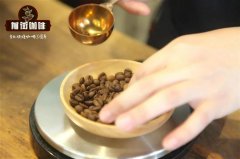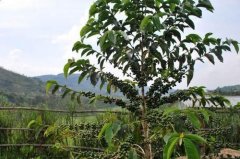Indian coffee beans need three to four months of wind soaking, green beans will increase by 2-3 times

Professional coffee knowledge exchange More coffee bean information Please pay attention to coffee workshop (Weixin Official Accounts cafe_style)
In fact, India is a country rich in coffee beans. About 250,000 people grow this economic product in the country. Coffee is suitable for growing in warm environments. The Tropic of Cancer between North and South is called the Coffee Belt.(coffee zone), but afraid of high temperature damage bean characteristics, so most planted in high altitude areas, India coffee beans are mainly produced in the southern mountains, although rainfall is not sufficient, but with irrigation equipment can also produce high levels of coffee beans, like to drink coffee lovers may know that India has a special bean "monsoon Malabar", beans low acidity contains rice flavor.
Indian Malaba Coffee or Monsooned Malaba Coffee has always been popular with Europeans, and this wind-stained coffee is a new flavor that has been inadvertently created. In the 17th and 18th centuries, India shipped coffee beans to Europe on sailboats, each trip taking six months. The raw beans were placed at the bottom of the ship's warehouse, absorbing the moisture and salt of the sea. When they arrived in Europe, the raw beans had deteriorated, and their color changed from dark green to brown rice. The fruit acid flavor of coffee almost disappeared, but unexpectedly developed a strong nut and shell flavor. Nordic people love this golden alternative coffee. In 1869, the opening of the Suez Canal and the advent of steamships shortened the sailing time between India and Europe, but customers began to complain that Indian coffee had "lost its taste" and lost its attractive brown and nutty flavor. Orders dropped sharply, and Indian exporters began to study solutions. Coffee shipped to Europe took more than half the time to mature and lose its original flavor. Exporters thought of the salty and humid environment blowing from the Indian sea off the coast of Malaysia in southwest India from late May to September every year. After several experiments, they produced a golden brown, acid-free coffee similar to that of the past, so they named it "monsoon coffee," commonly known as wind-stained coffee.
Wind-stained coffee needs to be made from sun-dried beans, and the wind-stained factory faces west in order to meet the salty and wet monsoon blowing from southwest. Coffee beans are laid flat in the wind stain field, the windows are fully open, and the bags are re-entered after the wind stains to a certain extent, but the coffee beans cannot be filled too full, and the coffee bags cannot be piled too tightly to avoid airtight and moldy, and the coffee beans should be poured out from time to time to replace the sacks to avoid breeding mold, which is quite time-consuming and labor-consuming. The air-curing period is about 12 to 16 weeks. After ripening, the beans are further fumigated to drive away weevils. Finally, the beans are manually sifted to remove failed beans that have not turned golden. After three to four months of wind soaking, green coffee beans expand one to two times in volume, weight and density decrease, moisture content is about 13%, quality and quantity have significant changes.
END
Important Notice :
前街咖啡 FrontStreet Coffee has moved to new addredd:
FrontStreet Coffee Address: 315,Donghua East Road,GuangZhou
Tel:020 38364473
- Prev

Indian-style Malabar coffee has been favored by Europeans since the 17th century.
Professional coffee knowledge exchange more coffee bean information Please follow the coffee workshop (official Wechat account cafe_style) refined wind-stained coffee on rainy days ~ we'll talk about it later. Coffee became the number one drink in the world only 1600 years later, so the recorded history of coffee is only 400 years similar to that of Taiwan. Most people recognize that Africa is the origin of coffee.
- Next

Have a glass of Costa Rican Carnett musicians series full of rice wine aroma-Bach.
Professional coffee knowledge exchange more coffee bean information please follow coffee workshop (Wechat official account cafe_style) ▲ click to follow | focus on the fifth anniversary of coffee roasting more boutique coffee beans please add private Wechat Qianjie, WeChat: (long click to copy) qiannjie Costa Rica Canet Musician Bach Costa Carnett musicians series Baja countries
Related
- Does Rose Summer choose Blue, Green or Red? Detailed explanation of Rose Summer Coffee plots and Classification in Panamanian Jade Manor
- What is the difference between the origin, producing area, processing plant, cooperative and manor of coffee beans?
- How fine does the espresso powder fit? how to grind the espresso?
- Sca coffee roasting degree color card coffee roasting degree 8 roasting color values what do you mean?
- The practice of lattes: how to make lattes at home
- Introduction to Indonesian Fine Coffee beans-- Java Coffee producing area of Indonesian Arabica Coffee
- How much will the flavor of light and medium roasted rose summer be expressed? What baking level is rose summer suitable for?
- Introduction to the characteristics of washing, sun-drying or wet-planing coffee commonly used in Mantenin, Indonesia
- Price characteristics of Arabica Coffee Bean Starbucks introduction to Manning Coffee Bean Taste producing area Variety Manor
- What is the authentic Yega flavor? What are the flavor characteristics of the really excellent Yejasuffi coffee beans?

